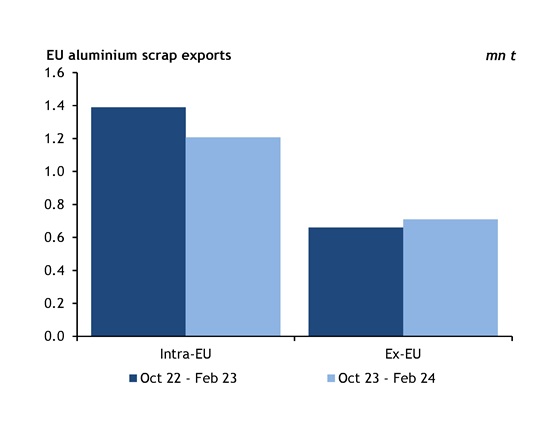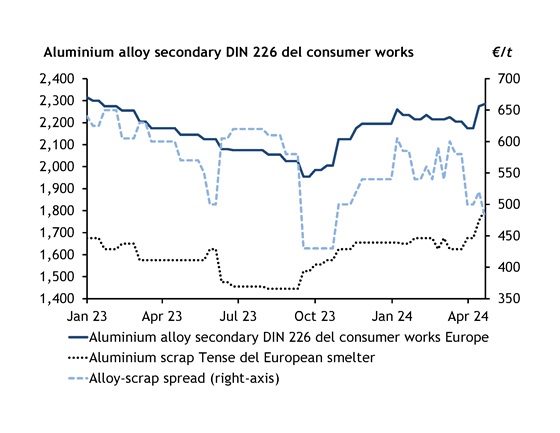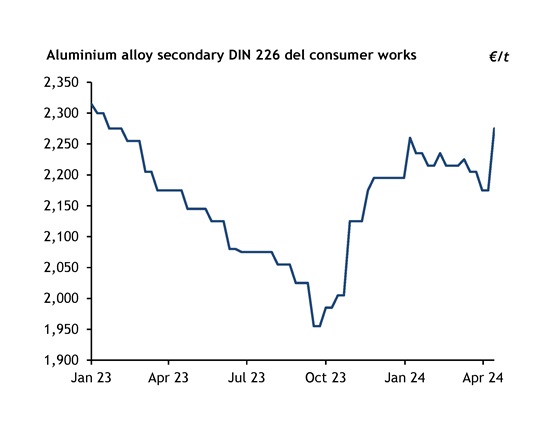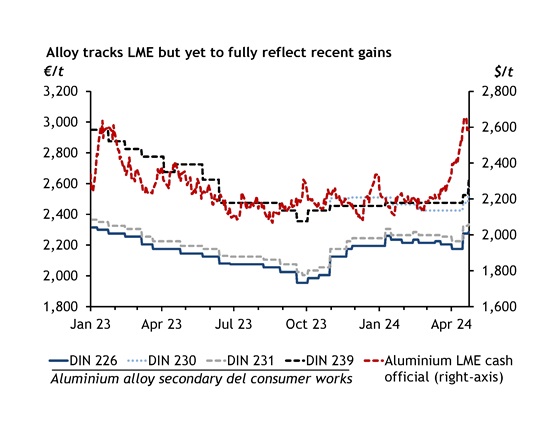European aluminium alloy producers are becoming increasingly concerned about the availability of aluminium scrap units, with a number of factors further suppressing that availability at a time when demand for alloy units is slowly increasing after a period of weak industrial activity.
Scrap supply levels in Europe have been tight for several years now, with the constant pull of strong international demand draining availability of scrap across the spectrum of grades. Buyers in Asia have long been major scrap consumers, most notably in India and China where unsophisticated but highly effective sorting methods allow for the processing of wide-ranging qualities of scrap metal.
In October 2023 to February 2024, EU exports of aluminium scrap outside the trading bloc rose by 7.4pc to 708,523t while exports of scrap within the trading area fell 13pc to 1.2mn t. Higher exports to China were a major driver for the shift.

The appetite for aluminium scrap from Asian markets has supported scrap prices in Europe as buyers have been forced to pay up to keep some units in domestic regions, leading to a fall in profit margins for aluminium alloy producers that use scrap as feedstock. This has been worsened by overall lower scrap generation levels in Europe, due to lower activity in construction markets and reduced factory output in a weakened European economy.
Scrap prices increased significantly more than alloy prices in 2023 and have risen further so far in 2024. The Argus assessment for taint/tabor scrap delivered to European works rose to €1,600-1,700/t on 25 April, up 4.8pc from €1,550-1,600/t at the start of the year, while the assessment for 2pc tense scrap has jumped 9pc to €1,780-1,830/t from €1,630-1,680/t at the start of the year.

Demand from Asia has, to the surprise of many in the industry, remained robust even against higher freight costs and longer lead times caused by the Red Sea crisis that has threatened cargoes passing through the Suez Canal and forced shipping to be rerouted around the Cape of Good Hope.
"Buyers in Asia are still offering very aggressively, even with the added costs of shipping," one alloy producer said.
Against such tight scrap availability in Europe, alloy demand is starting to improve. As alloy producers face better demand for their products, they are now looking to the scrap market to cover their raw material requirements for those second and third-quarter products. And they are finding inadequate reserves on offer.
"There may not be enough to go around," the alloy producer said.
And there are other factors sapping scrap supply in Europe, or raising domestic demand for it. The push for ever greener primary aluminium has prompted the development of improved technology that has enabled primary metal producers to utilise more scrap units in their production, by allowing for the processing of grades that used to be of too low quality for primary smelters to incorporate. This trend has further diminished the availability of scrap units for secondary aluminium producers.
And the EU's carbon border adjustment mechanism, which entered its transitional phase in October ahead of its full implementation in January 2026, has left many importers scrambling to find alternative sources this year and next as their current suppliers cannot provide the required information under the legislation. With some product imports likely to be cut off from Europe, the demand for domestically produced units and their scrap feedstock will increase.
Some alloy producers have been trying to raise alloy prices consistently this year in order to keep pace at least to an extent with last year's scrap price rises, but the persistence of lower alloy offers from producers prioritising the shifting of volumes has dragged on those efforts.
Alloy prices have also been mostly steady in 2024 so far, sustaining the enormous pressure on alloy producer profit margins, and have only seen notable increases in the latter half of April as producers have finally extinguished the lower offers in the face of daunting scrap costs. Prices even dropped at the end of March as suppliers worked through a backlog of inventory. The Argus weekly assessment for DIN 226 alloy delivered to consumer works stood at €2,280-2,330/t on 8 May, up from €2,170-2,220/t at the start of the year and from €2,150-2,200/t in early April.

But scrap prices have proved far more mobile under pressure, and that pressure will increase in the coming months as demand for alloys recovers further.
"Demand for alloys is OK now, but prices are still very low," a second alloy producer said. "There isn't much scrap available, which will become a huge problem if alloy demand goes higher."

By: Jethro Wookey, Associate Editor, Metals

